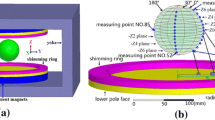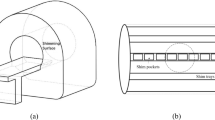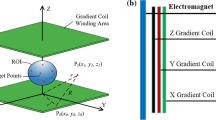Abstract
The main magnet in a magnetic resonance imaging (MRI) system creates a static magnetic field that determines the final imaging quality. In a permanent MRI system, shimming rings are commonly used to improve field homogeneity. However, the optimization of the ring structure is challenging owing to the nonlinear properties of the ferromagnetic material. To design a small permanent magnet system, this study explores the application of sensitivity analysis (SA) and particle swarm optimization (PSO) algorithm for the optimization of shimming rings. SA is used to identify the most important parameter of the shimming rings that affects the quality of the magnetic field to simplify the optimization process and improve optimization accuracy and efficiency. PSO is used to solve the complex and nonlinear optimizations of the magnetic field. To illustrate the effectiveness of the proposed method, a specific permanent MRI magnet was modeled. The results show that the inner radius of the shimming ring crucially affects magnetic field quality, with ring height having relatively smaller impact. Compared with the PSO-only optimization procedure, the combined SA-PSO optimization more rapidly converges to a better solution. The optimized shimming rings significantly improve the magnetic field uniformity (~10 fold) compared with that of the initial magnet without shimming rings.







Similar content being viewed by others
References
Raich, H., & Blümler, P. (2004). Design and construction of a dipolar Halbach array with a homogeneous field from identical bar magnets: NMR Mandhalas. Concepts in Magnetic Resonance Part B, 23, 16–25.
Kato, H., Kishi, K., Takahashi, N., Asaumi, J. I., Honda, Y., Yanagi, Y., & Aoki, M. (2008). A design of permanent magnet array for unilateral NMR device. Concepts in Magnetic Resonance Part B, 33, 201–208.
Moresi, G., & Magin, R. (2003). Miniature permanent magnet for table-top NMR. Concepts in Magnetic Resonance Part B, 19, 35–43.
Anferova, S., Anferov, V., Rata, D., Blümich, B., Arnold, J., Clauser, C., et al. (2004). A mobile NMR device for measurements of porosity and pore size distributions of drilled core samples. Concepts in Magnetic Resonance Part B, 23, 26–32.
Lee, D., & Marcinek, D. (2009). Noninvasive in vivo small animal MRI and MRS: Basic experimental procedures. Journal of visualized experiments, 20(32), e1592.
Podol’skii, A. (2000). Design procedure for permanent magnet assemblies with uniform magnetic fields for MRI devices. IEEE Transactions on Magnetics, 36, 484–490.
Juchem, C., Muller-Bierl, B., Schick, F., Logothetis, N. K., & Pfeuffer, J. (2006). Combined passive and active shimming for in vivo MR spectroscopy at high magnetic fields. Journal of Magnetic Resonance, 183, 278–289.
Ryu, J. S., Yao, Y., Koh, C. S., Yun, S., & Kim, D. S. (2005). Optimal shape design of 3-D nonlinear electromagnetic devices using parameterized design sensitivity analysis. IEEE Transactions on Magnetics, 41, 1792–1795.
Sanchez Lopez, H., Liu, F., Weber, E., & Crozier, S. (2008). Passive shim design and a shimming approach for biplanar permanent magnetic resonance imaging magnets. IEEE Transactions on Magnetics, 44, 394–402.
Tadic, T., & Fallone, B. G. (2010). Design and optimization of a novel bored biplanar permanent-magnet assembly for hybrid magnetic resonance imaging systems. IEEE Transactions on Magnetics, 46, 4052–4058.
Tadic, T., & Fallone, B. G. (2011). Three-dimensional nonaxisymmetric pole piece shape optimization for biplanar permanent-magnet MRI systems. IEEE Transactions on Magnetics, 47, 231–238.
Fesanghary, M., Damangir, E., & Soleimani, I. (2009). Design optimization of shell and tube heat exchangers using global sensitivity analysis and harmony search algorithm. Applied Thermal Engineering, 29, 1026–1031.
Homma, T., & Saltelli, A. (1996). Importance measures in global sensitivity analysis of nonlinear models. Reliability Engineering and System Safety, 52, 1–17.
Yang, J. (2011). Convergence and uncertainty analyses in Monte-Carlo based sensitivity analysis. Environmental Modelling and Software, 26, 444–457.
Pan, Q. K., Fatih Tasgetiren, M., & Liang, Y. C. (2008). A discrete particle swarm optimization algorithm for the no-wait flowshop scheduling problem. Computers & Operations Research, 35, 2807–2839.
Im, S. (2001). Global sensitivity indices for nonlinear mathematical models and their Monte Carlo estimates. Mathematics and Computers in Simulation, 55, 271–280.
Chan, K., Saltelli, A., & Tarantola, S. (1997) Sensitivity analysis of model output: Variance-based methods make the difference. In Proceedings of the 29th Winter simulation Conference, (pp. 261–268).
Saltelli, A. (2002). Making best use of model evaluations to compute sensitivity indices. Computer Physics Communications, 145, 280–297.
Kennedy, J., & Eberhart, R. (1995) Particle swarm optimization. In Proceedings of International Conference on Neural Networks, 1942–1948.
AlRashidi, M., & El-Hawary, M. (2009). A survey of particle swarm optimization applications in electric power systems. IEEE Transactions on Evolutionary Computation, 13, 913–918.
del Valle, Y., Venayagamoorthy, G. K., Mohagheghi, S., Hernandez, J. C., & Harley, R. G. (2008). Particle swarm optimization: Basic concepts, variants and applications in power systems. IEEE Transactions on Evolutionary Computation, 12, 171–195.
Marble, A. E., Mastikhin, I. V., Colpitts, B. G., & Balcom, B. J. (2005). An analytical methodology for magnetic field control in unilateral NMR. Journal of Magnetic Resonance, 174, 78–87.
Marble, A. E., Mastikhin, I. V., Colpitts, B. G., & Balcom, B. J. (2007). Designing static fields for unilateral magnetic resonance by a scalar potential approach. IEEE Transactions on Magnetics, 43, 1903–1911.
Acknowledgments
This work was supported in part by the 973 National Basic Research & Development Program of China (2010CB732502) and the National Science & Technology Pillar Program of China (2011BAI12B01).
Author information
Authors and Affiliations
Corresponding author
Rights and permissions
About this article
Cite this article
Cheng, Y., He, W., Xia, L. et al. Design of Shimming Rings for Small Permanent MRI Magnet Using Sensitivity-Analysis-Based Particle Swarm Optimization Algorithm. J. Med. Biol. Eng. 35, 448–454 (2015). https://doi.org/10.1007/s40846-015-0051-6
Received:
Accepted:
Published:
Issue Date:
DOI: https://doi.org/10.1007/s40846-015-0051-6




